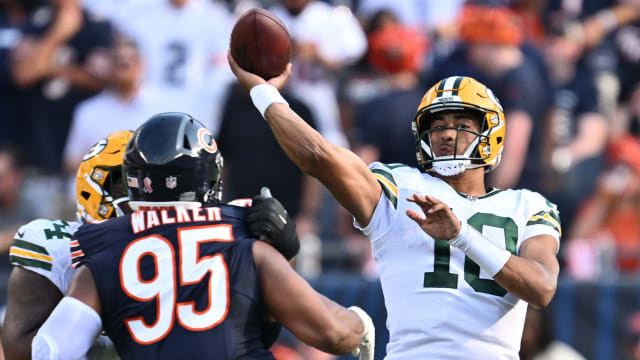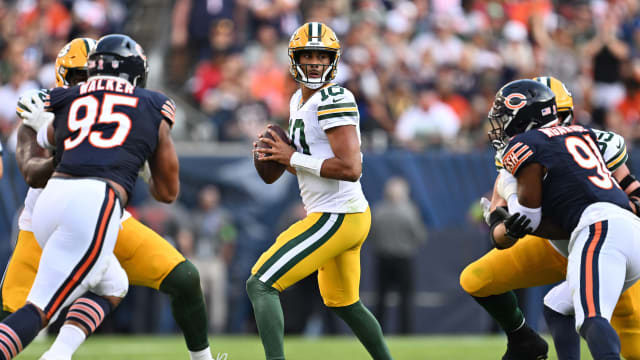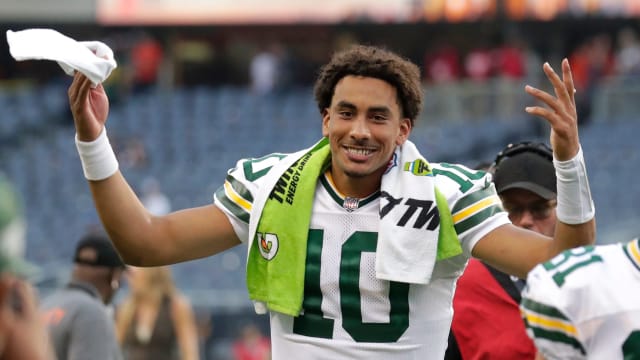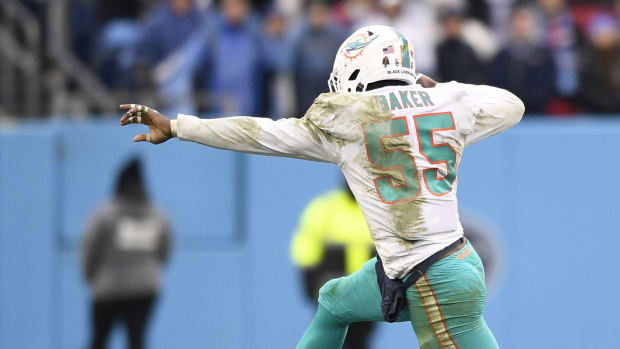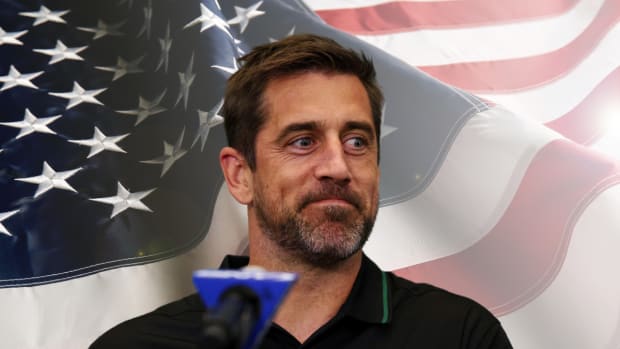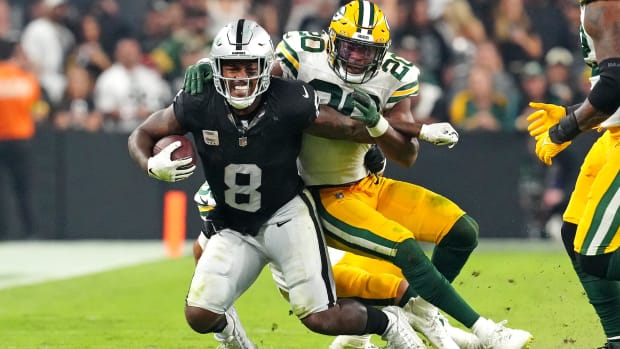
Three Reasons Why Packers Will Lose to Bears, Miss Playoffs
GREEN BAY, Wis. – The Green Bay Packers were dead and buried in 2022 with their 4-8 record. Same in 2023 after starts of 2-5 and 3-6, followed by embarrassing back-to-back losses against the New York Giants and Tampa Bay Buccaneers.
In 2022, the Packers won four in a row to host a win-and-in Week 18 showdown against the rapidly improving Detroit Lions.
They lost.
In 2023, the Packers have won two in a row to host a win-and-in Week 18 game against the Chicago Bears, who have won four of their last five.
Will history repeat itself? Here are three reasons why the Bears could crash Green Bay’s playoff party.
1. Khalil Herbert and Justin Fields vs. the Packers
Explosive Bears running back Khalil Herbert didn’t practice on Friday and is questionable with a back injury. However, the expectation is Herbert will play.
This hasn’t been the season anyone expected when the Bears let David Montgomery sign with the rival Lions and handed the keys to the running game to Herbert, who averaged a robust 5.7 yards per carry in 2022.
Through Week 15, he had 350 rushing yards and zero touchdowns. However, in back-to-back wins, Herbert carried 20 times for 112 yards and one touchdown vs. the Cardinals and 18 times for 124 yards and one touchdown vs. the Falcons. He had seven of his 15 runs of 10-plus yards in those games.
“I’ve always thought that kid’s a heck of a back, even when in years past when Montgomery’s been there,” defensive coordinator Joe Barry said. “Got a lot of respect for him as a runner.”
Of course, Green Bay’s problems stopping the run hardly need to be addressed. The Packers are 28th in rushing yards allowed per game (131.6) and 26th in yards allowed per carry (4.50). It has, however, played relatively well the last three weeks.
Since allowing 209 rushing yards and a 6.1 average against the Giants, Barry’s defense has limited the Buccaneers to 99 yards on 27 attempts (3.7 average), the Panthers to 96 yards on 25 tries (3.8 average) and the Vikings to 67 yards on 16 carries (4.2 average).
The Packers will have to contend with more than just Herbert. Quarterback Justin Fields, despite missing four games, ranks second at the position with a team-high 630 rushing yards. (More on him on Sunday’s “Big Matchup” story.) Herbert’s backfield running-mates, Roschon Johnson (6-foot, 225 pounds) and veteran D’Onta Foreman (6-foot, 235 pounds), are physical runners. And their receivers and even tight end Cole Kmet have gotten the ball 26 times.
“They do a great job running the ball, whether it’s conventional runs, quarterback-design runs,” Barry said. “I think they’ve done a great job of getting their receivers in fly sweeps and all those things. They challenge you on the perimeter. They can line up in smashball and do all those things, as well. They’re second in the league in rushing for a reason.
“So, it’s going to be a great challenge for us, but I think the consistent part of it, that’s the thing that I’m looking for. We’ve been consistent pretty good here the last couple weeks. So, that’s the challenge this week, is having a team that is good running the ball, wants to run the ball, and the challenge is, ‘Let’s go stop and knock it out.’”
2. Aaron Jones vs. the Bears
Why have the Packers won two games in a row? A starting point, obviously, is the play of running back Aaron Jones. Fully healthy following a knee injury and fresh after a season-long battle with injuries, Jones carried 21 times for 127 yards (6.0 average) vs. Carolina and 20 times for 121 yards 6.1 average) against the Vikings.
“Obviously, their offense runs through Jones,” Bears coach Matt Eberflus said this week.
Through Week 15, according to Pro Football Focus, Jones had forced eight missed tackles and had two runs of 10-plus yards. The last two games, he forced 11 missed tackles and had nine runs of 10-plus yards.
“He’s an explosive player. Anytime he gets the ball, he’s ready to make that happen,” quarterback Jordan Love said. “The running game’s picked up a lot, and it obviously takes some air out of the passing game when you can just hand the ball off to him and make some big plays, and now the defense has got to focus on that.”
Chicago’s run defense is as tough as they come. The Bears are No. 1 with 84.0 rushing yards allowed per game and No. 4 with 3.72 yards allowed per carry. The Packers with Jones for most of the game averaged 2.9 per attempt in Week 1.
It’s an 11-man effort led by defensive lineman Andrew Billings, inside linebackers Tremaine Edmunds and T.J. Edwards, and a sound secondary.
“They’re just really stout. They’re very sound,” coach Matt LaFleur said. “They do a great job controlling gaps, loading the box and mixing coverage. When you look at their defense as a whole, there’s really no weakness in terms of their ability to go out there and tackle.
“Their corners are very physical. I think a lot of times when you look at good-tackling teams, you expect it from the front seven, and we know how good those backers are inside, but their back end is a bunch of very good tacklers. I think that just makes it that much harder to run the football. We’ll have our work cut out for us.”
If the Packers can’t get the running game going, it will flow right into the strength of Chicago’s defense. Which is …
3. Turnovers
No statistic is more important than turnovers. And the Bears have dominated down the stretch. They are third with 27 takeaways and first with 22 interceptions. The last six games, they’ve forced 18 turnovers with 16 interceptions.
To be sure, a lot of those came against bad quarterbacks – and Jordan Love, with one interception the last seven games, is not a bad quarterback. But five came against the Lions’ Jared Goff, who is ninth in passer rating and has only seven interceptions in his other 14 games.
“These guys do a really good job of reading your eyes, so as you look to go throw to a receiver, if you’re late or if you double-clutch it, they react to that and they make plays on the ball,” LaFleur said.
“We always talk about zoning defenses, like these guys are on a string, So, as you move, the whole defense moves, and they just work in unison together very well. It allows them to make a lot of plays on the ball.”
Standout veteran cornerback Jaylon Johnson, impressive rookie cornerback Tyrique Stevenson and Edmunds are tied for seventh in the NFL with four interceptions. Edwards, the former Wisconsin star, has three.
“All those guys in the back end on their second level, those linebackers included, they have really good ball skills,” LaFleur said. “So, you’ve got to be on time. You’ve got to be on rhythm. You’ve got to be willing to get off things if it looks a little bit muddy and maybe find a checkdown.”
The key for Green Bay will be protecting Love, and that starts with keeping Montez Sweat at bay. Acquired at the trade deadline, Sweat has a team-high six sacks in eight games. A couple weeks after his arrival, the takeaways started flowing.
As has been the case for most of the season, the job of keeping the opponent’s top pass rusher away from Love will fall on right tackle Zach Tom. For the season, Sweat rushes 87 percent from the defense’s left side, according to Pro Football Focus.
“He creates a pressure player from the front and, when you have that, then you’re able to play coverage,” Eberflus said this week. “Then, you can vary your coverages. You can make them look different and disguise them. I think that’s very hard on the quarterback. So, when you have that pressure player from the front and you’re not bringing it from the second level, that helps out any defense. Certainly, Tez has been wonderful to have. He’s helped out the whole organization.”

